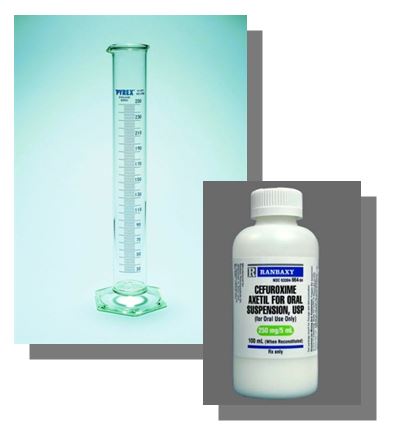How to Reconstitute Antibiotic Suspensions
2016.05.03
Recommendations for Healthcare providers working in non-pharmacy settings
When providing antibiotic suspensions is not possible through a pharmacy, front line healthcare providers may be called upon to reconstitute suspensions directly.
Here are some recommendations by GMHS pharmacy in Winnipeg and safety guidelines to ensure the patient receives the right dosage concentration and limits the risk of contamination of the product.

Definition of antibiotic reconstitution: Adding water to an antibiotic in powdered form in order to change it into a liquid form. The liquid is often referred to as a suspension (because the product “suspends” in the water).
When providing antibiotic suspensions is not possible through a pharmacy, front line healthcare providers may be called upon to reconstitute suspensions directly.
Here are some recommendations by GMHS pharmacy in Winnipeg and safety guidelines to ensure the patient receives the right dosage concentration and limits the risk of contamination of the product.
Definition of antibiotic reconstitution: Adding water to an antibiotic in powdered form in order to change it into a liquid form. The liquid is often referred to as a suspension (because the product “suspends” in the water).
1. Shake Powder
Always lightly shake the powder in a bottle prior to adding water. This helps to prevent any of the powder from sticking to the bottom or sides of the bottle, and makes reconstitution easier.2. Use Clean Water
When reconstituting antibiotic suspensions it is recommended that distilled, sterile or bottled water be used in order to retard the development of bacterial growth, especially if the reconstituted mixture will not be stored in a refrigerator by the patient. (e.coli bacteria sometimes found in ground water will multiply rapidly if placed in a sugar environment). ADVISE PATIENTS WHEREVER POSSIBLE TO REFRIGERATE THEIR ANTIBIOTIC SUSPENSIONS. There are exceptions as specifically directed on an antibiotic suspension bottle.3. Read reconstitution instructions thoroughly
All manufactured products that require reconstitution have the proper procedure for reconstitution written on the label. Always refer to these instructions. It is not a satisfactory reconstitution process to simply “fill with water up to the line”.4. In 2 portions
When instructions request that water be added in two portions, pour the total amount of water required into a graduated cylinder, then pour half of the measured amount into the antibiotic, replace lid and shake, then add the second half, replace the lid and complete shaking until no powder remains.5. Time required to mix
The average length of time a suspension should be shaken is 30 seconds to 1 minute.6. Confirming completion
Always inspect the bottom of the container after shaking is completed to confirm all the powder had been mixed. Should you see any powder remaining, shake for another 30 seconds and inspect. Repeat as necessary.7. Manually mixing
NEVER stick a tool into the bottle to aid in the mixing of any sticking powder. This will contaminate the bottle and could lead to accelerated bacterial growth. Instead, if powder remains on the bottom, tap the bottle on your hand or on the edge of the counter to loosen any residual powder and continue shaking.8. Difficulties in reconstituting
Certain powders have a difficult time reconstituting and one may find that powder remains regardless of the amount of shaking. The powder with eventually merge into the liquid. ALWAYS ADVISE PATIENTS TO SHAKE THEIR ANTIBIOTIC SUSPENSION PRIOR TO EACH USE.9. Expiry Date
An expiry date of 14 days or as indicated on the bottle by the manufacturer should be indicated on antibiotic suspensions. Count the number of days from when the medication has been reconstituted.10. Cleaning procedures
Finally, always rinse out the graduated cylinder immediately after each use as antibiotic powder often escapes from the bottle when water is added and sticks to the cylinder. A cylinder not routinely cleaned in this fashion could cause cross contamination and increase the risk of allergic reaction in susceptible patients. Further, store the graduated cylinder upside down or covered to avoid debris or dirt entering between uses.The procedure for reconstituting an antibiotic (Chart):
READ
Read instructions on antibiotic bottle to determine the quantity of liquid that is required and the method to be used to mix (reconstitute). Wear gloves or wash hands before and after reconstituting.LOOSEN
Before opening the bottle, turn bottle upside down and shake lightly to loosen the powder. This makes reconstitution easier.MEASURE
Hold the graduate in one hand and add the required amount of liquid. Ensure there is a correct amount of water in the graduate by placing the graduated cylinder on a level surface and examining at eye level.MIX
Pour liquid into the antibiotic bottle as per its instructions. Re-seal and shake the bottle until all the powder becomes liquefied. Confirm by inspecting the bottom of the container for any dry powder remaining.STORAGE & EXPIRY
Among the other instructions provided with the bottle, remember to mark storage instruction and expiry date on the packaging.More Articles
Copyright © Fooyoh.com All rights reserved.